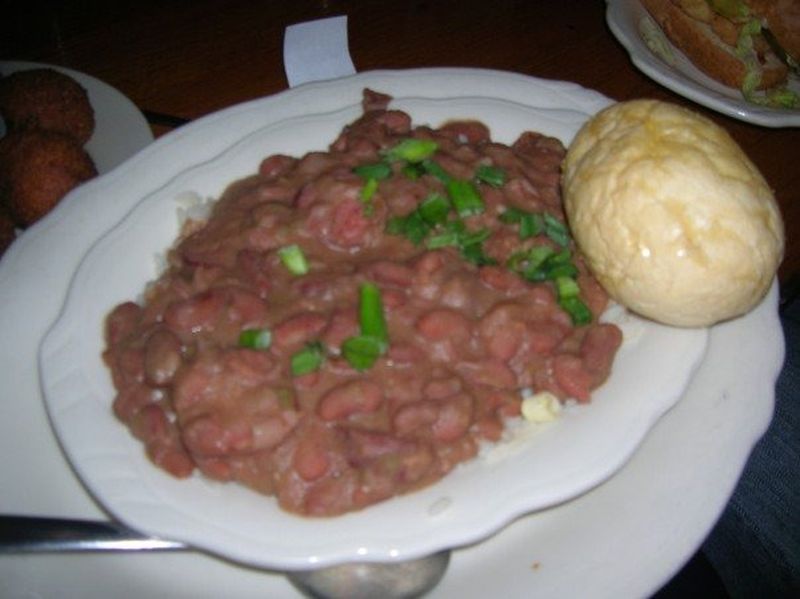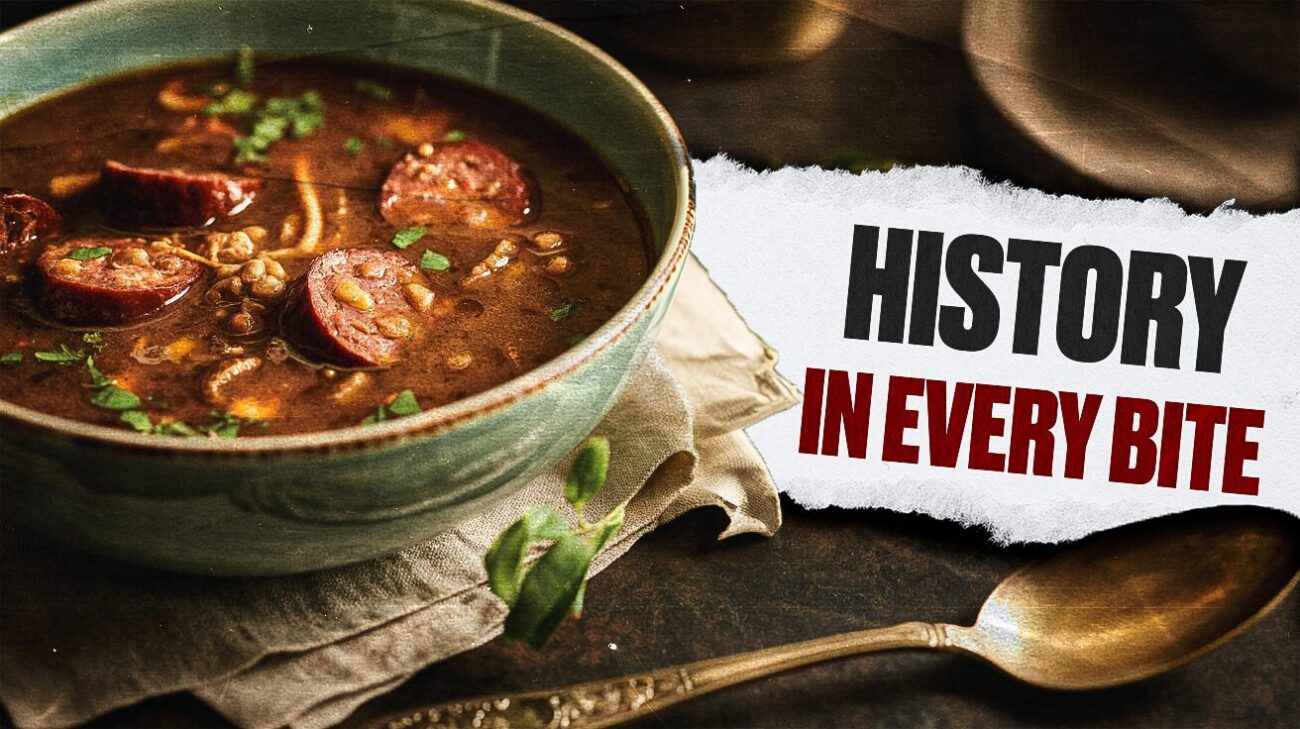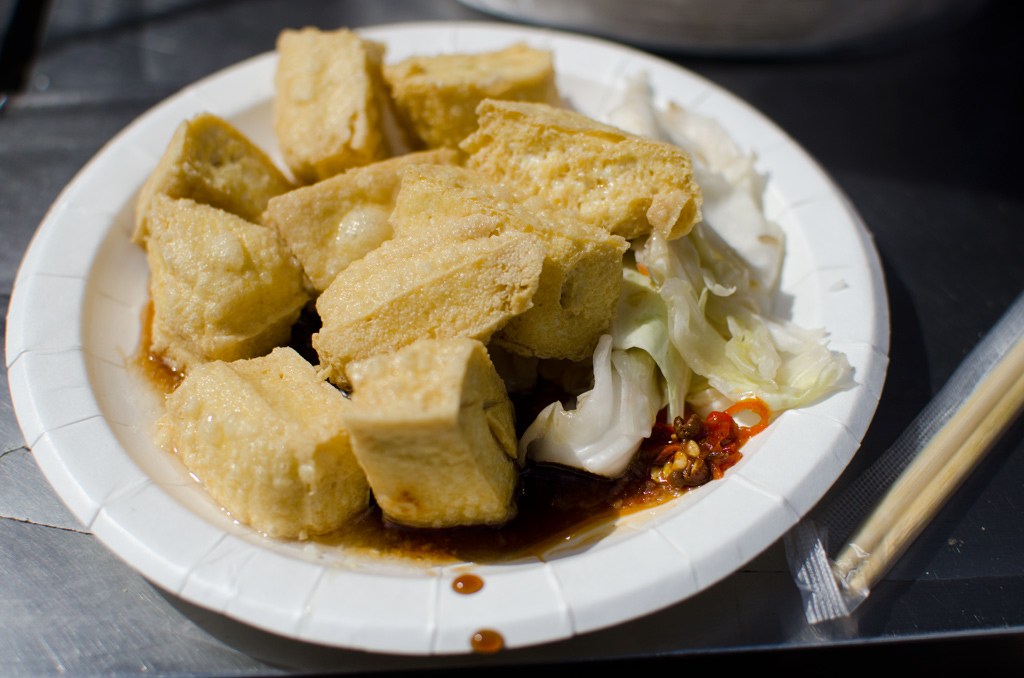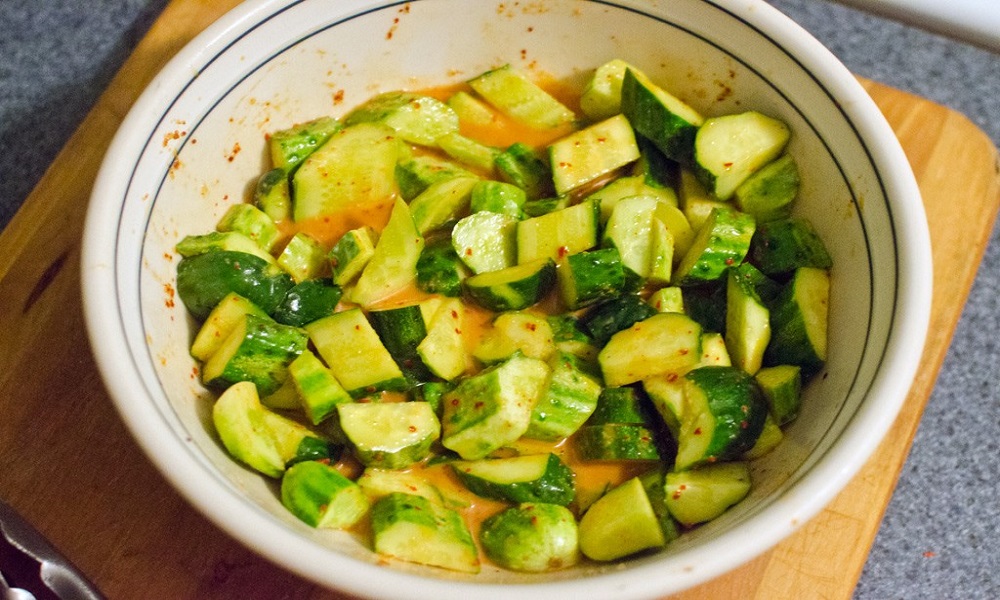Nearly 300 years of French, Spanish, African, Caribbean, and Native American influences have simmered together in this Louisiana port city, creating a culinary landscape where every dish carries whispers of history. New Orleans cuisine emerged from the complex social hierarchies of colonial life, where enslaved African and Caribbean cooks combined European techniques with their own ingredients and spices, birthing something entirely new. Each bite connects you to centuries of cultural exchange, migration, and creative fusion—from the okra-thickened gumbo that echoes West African traditions to the jambalaya that transforms Spanish paella dreams into Creole reality.
9. Gumbo

Since the early 1800s, this complex stew has been New Orleans’ liquid heritage.
Gumbo serves as a culinary echo chamber where French bouillabaisse whispers to West African okra, and Spanish spices dance with Choctaw file powder. The dish demonstrates New Orleans’ multicultural DNA through its very construction—dark roux provides the French foundation, while okra (from the West African Bantu word “ki ngombo”) adds both vegetable and thickening agent. Much like jazz, gumbo riffs on available ingredients, improvising with seafood, chicken, or vegetables.
The foundational cooking technique lies in the roux, a combination of flour and butter darkened over heat until it reaches the perfect nutty complexity. Whether served at establishments like Grey Gris or St John, each bowl tells stories of resilience and innovation. The fragrant steam carries bay leaves and memories, transforming simple ingredients into something that flows through the city’s veins like the Mississippi itself.
8. Jambalaya

This one-pot rice dish transforms Spanish paella dreams into distinctly Creole reality.
Legend traces jambalaya’s origins to the early 1800s when Spanish colonists attempted to recreate paella but lacked saffron. They turned to tomatoes and Caribbean spices instead, creating something entirely new. The name itself reflects this cultural fusion—possibly combining “jambon” (French for ham) with “aya” (West African for rice). Each grain absorbs the essence of French finesse, Spanish zest, and African soul.
Creole jambalaya typically includes tomatoes, earning the nickname “red jambalaya,” while Cajun versions remain tomato-free. Both variations rely on the Holy Trinity—onions, bell peppers, and celery—as their aromatic foundation. At spots like Parkway Tavern, the communal nature of jambalaya shines through, bringing people together around steaming plates that celebrate the city’s vibrant, ever-evolving story.
7. Po’Boy Sandwiches

These overstuffed French bread creations emerged from New Orleans’ working-class hunger.
Po’boy sandwiches represent the city’s ability to transform simple ingredients into comfort food magic. Crisp French bread yields to mountains of fried shrimp, succulent oysters, flaky catfish, tender roast beef, or juicy fried chicken. The contrast between crunchy exterior and tender filling creates textural poetry that satisfies like few other sandwiches can.
Establishments like D’s and Parkway Tavern have elevated the po’boy to art form, understanding that proper execution requires balance—enough filling to impress without overwhelming the bread’s structure. When hunger strikes with Mississippi thunderstorm force, the po’boy answers with portable satisfaction. The sandwich embodies New Orleans’ democratic spirit, offering substantial nourishment at accessible prices while maintaining the city’s commitment to flavor above all else.
6. Andouille Sausage

This double-smoked sausage arrived from France between 1755-1764, forever changing Louisiana’s flavor profile.
Andouille sausage distinguishes itself through its thick profile and complex smoking process. Crafted from pork and seasoned with garlic, onions, and spice blends, andouille packs intensity that elevates ordinary dishes to extraordinary heights. The sausage underwent transformation in Louisiana, influenced by German sausage-making traditions that also flourished in the multicultural city.
Beyond standalone enjoyment, andouille serves as a flavor catalyst in dishes like gumbo, jambalaya, and red beans and rice. The smoky notes dance through each grain and spoonful, creating culinary tapestries that comfort and intrigue simultaneously. Home cooks discover andouille’s versatility by incorporating it into pasta dishes or grilled sandwiches, bringing New Orleans heat to unexpected places.
5. Beignets

These cloud-like pastries dusted with powdered sugar represent New Orleans’ sweetest daily ritual.
Beignets transcend simple fried dough, serving as culinary embraces passed down through generations. The perfectly executed beignet achieves delicate balance—crispy exterior yielding to pillowy interior, all crowned with generous powdered sugar snowfall. At institutions like Café Du Monde, beignets pair with café au lait in morning rituals that locals and visitors alike cherish.
The magic lies in timing and technique. Fresh beignets arrive hot, the powdered sugar creating sweet clouds with each bite. They represent New Orleans’ improvisational spirit—like jazz pastries that adapt to moment and mood. Whether enjoyed in the French Market’s bustling atmosphere or quiet café corners, beignets offer sweetness that connects directly to the city’s soul.
4. Muffuletta

This Sicilian-inspired sandwich layers cured meats with tangy olive salad on round bread.
The muffuletta showcases New Orleans’ Italian immigration influence through its construction on round Sicilian bread, sliced horizontally and layered with salami, ham, and mortadella. The sandwich’s defining element—olive salad mixed with celery and pickled vegetables—cuts through rich meats and cheese with acidic brightness. This tangy component transforms what could be ordinary cold cuts into flavor complexity.
At establishments like Central Grocery, proper muffuletta construction requires surgical precision in layering. The sandwich’s substantial size makes sharing traditional, turning lunch into communal celebration. The olive salad’s marinated flavors improve over time, making day-old muffuletta often superior to fresh versions as ingredients meld together into harmonious whole.
3. Red Beans and Rice

Monday’s traditional dish transforms humble ingredients into Creole comfort food perfection.
Monday has traditionally been “red beans and rice day” in New Orleans, establishing weekly rhythm that connects culinary tradition with work schedules. The dish slow-cooks kidney beans with Cajun spices, often accompanied by andouille sausage, creating comfort that transcends simple sustenance. Each pot tells slightly different stories while remaining true to foundational principles.
The tradition developed from practical considerations—Monday washday left little time for elaborate cooking, but beans could simmer unattended. At establishments like Café Reconcile, the Monday ritual continues, filling air with aromatic reminders that simplest things often offer greatest solace. The dish exemplifies New Orleans’ ability to transform necessity into celebration, proving humble ingredients achieve perfection through patience and love.
2. Bananas Foster

Brennan’s restaurant created this flambéed tableside spectacle in 1951.
Bananas Foster transforms simple fruit into caramelized symphony through butter, brown sugar, cinnamon, and rum. The tableside preparation adds theatrical element—bananas swimming in decadent sauce before dramatic flambé ignition. Brennan’s French Quarter location elevated dessert into experiential dining, offering sweet escape through both flavor and performance.
Served over vanilla ice cream, the warm boozy fruit contrasts with cool creamy base, creating temperature and texture interplay. The rum’s flame burns off alcohol while concentrating flavors, leaving behind essence that mingles with caramelized sugar. Each spoonful carries echoes of bygone hospitality era when dining represented entertainment as much as nourishment.
1. Hurricane

This potent rum cocktail packs tropical punch with mischievous New Orleans spirit.
The Hurricane combines light and dark rum with passion fruit syrup, lemon juice, and grenadine, creating deceptively smooth cocktail that masks considerable alcohol content. Served over crushed ice in distinctive hurricane glass, the drink embodies New Orleans’ ability to make dangerous things beautiful. Pat O’Brien’s Dueling Piano Bar on Bourbon Street popularized this fruity concoction that starts as tropical breeze but can quickly become memory-blurring adventure.
The cocktail’s reputation extends beyond taste to cautionary tale territory. What begins as festive toast can evolve into unexpected evening detour, reflecting the city’s mischievous character. The Hurricane represents New Orleans’ philosophy that even drinks should possess personality—sweet enough to seduce, strong enough to surprise, and memorable enough to become part of the city’s legendary storytelling tradition.


















